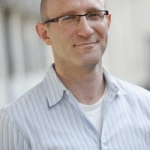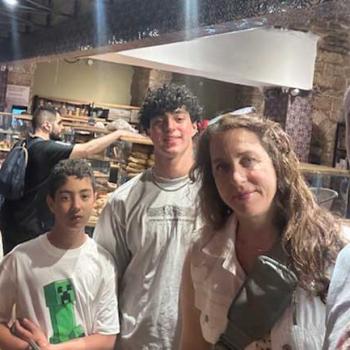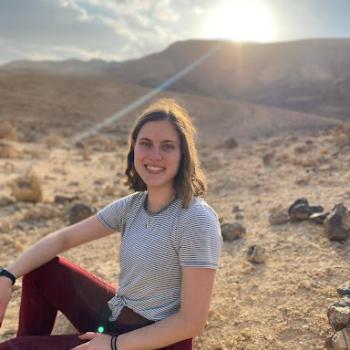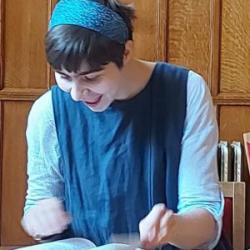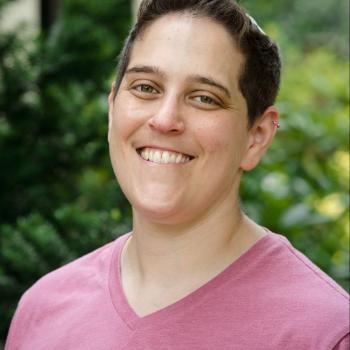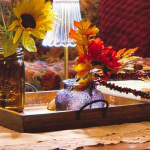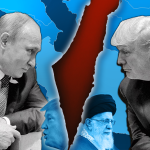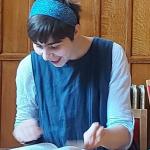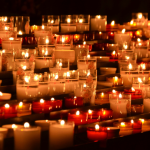Parashat Mishpatim Exodus 21:1-24:18
Recently, I attended a cozy concert by one of my favorite singer-songwriters. Halfway through, the music was interrupted by a distracting buzzing sound. The performer watched us dig through our bags from her perch onstage with amusement. Suddenly, she leapt toward her own bag at the foot of the stage. “Sorry about that,” she explained. “Every night at 10:00 I have an alarm set to remind me ‘Hey – You’re allowed to enjoy life today.’ I need to be reminded a lot lately.”
I thought of this artist and her nightly alarm when I read this week’s parasha, Mishpatim. At the heart of the climactic encounter at Sinai, the text opens a strange window onto the Divine image. Amidst the smoke and fire, after the outpouring of laws and commandments, Moshe and Aharon are instructed to ascend Har Sinai along with Nadav, Avihu, and seventy elders of Israel.
ויראו את אלהי ישראל ותחת רגליו כמעשה לבנת הספיר וכעצם השמים לטהר:
“And they saw the G!d of Israel—under whose feet was the likeness of sapphire brickwork, like the substance of the heavens for purity.” (Exodus 24:10).
We read that “they saw the G!d of Israel” – but the description directs our attention towards what is below G!d’s feet. Kema’aseh livnat hasapir – the likeness of sapphire brickwork. What are these strange brick-like gems doing at G!d’s feet?
Rashi offers: “It was placed before the Holy One during the Israelites’ time of enslavement, to remind Him of Israel’s woes – for they were subjected to make bricks” (Rashi on Ex. 24:10).
In Rashi’s version of events, the bricks had been at G!d’s feet for hundreds of years. Their purpose was to make sure She never forgot Bnei Yisrael’s oppression in Egypt. A midrash is more imaginative: suggesting that a trowel and basket were also nestled beside the bricks. (Vayikra Rabbah 23:8).
Maybe, these commentators are saying, the bricks were exactly what the 70 elders needed to see as they headed up Har Sinai, hoping to bring back encouraging reports to the nervous folks gathered below. The bricks were proof that G!d really did hear the Israelites’ cry. Although freedom had been a long time coming, G!d never abandoned them.
Yet I imagine a few of the elders shifting uncomfortably in their sandals, a concerning question forming in their minds: Why did G!d need a daily reminder of human suffering? It’s hard not to cringe at the idea of the Divine showing up to work at a desk with a little sapphire notecard: ‘IMPORTANT – Israelites are enslaved. Do not forget!’
The truth is, my own life is organized by a parade of reminders. My partner and former housemates can tell you about my very annoying, endlessly-snoozed alarms: Call Savta, call the doctor, water the plants, take out the trash. These things are important to me, and the reminders help me stay focused amidst constant distraction. Lately, I’ve also been finding I need reminders far beyond the surface-level to-do list. Every morning, headlines flood my mind with violence, fear-mongering, dehumanization, and lies. I feel the impulse to freeze and hide. Instead, I try to reach for a grounding reminder that can keep me from the brink of panic and apathy, and bring me back to what I believe is possible.
Our tradition puts great stock in the power of reminders to influence the ways we move through the world. On the night before the Israelites leave Egypt, G!d instructs the people that they will use physical reminders on their bodies to remember their liberation: “And this shall serve you as an ot, a sign on your hand and as a zikaron, a reminder on your forehead —in order that the Teaching of Adonai may be in your mouth—that with a mighty hand Adonai freed you from Egypt” (Exodus 13:9).
In giving the mitzvah of tefillin, our Divine teacher understands that humans need more than a memory to pull us back to what matters most. Tefillin are a tactile invitation to confront our collective history every day, a giant flashing arrow of meaning pointed at our head and our heart: “HEY! Step out of whatever is washing over you now. You are part of a much bigger story. That means you have responsibilities in this world. Do not let yourself get distracted.”
As Bnei Yisrael’s relationship with G!d grows, the spiritual reminders multiply: mezuzot, tzitzit, Shabbat, chagim – every one of these is consistently called a ‘reminder’ or a ‘sign’ by the Torah and our Sages. These holy objects and sanctified times can snap us out of whatever is swirling about, and reconnect us to what is central. Over the generations, our communities have only expanded our use of reminders. Consider the diversity of head coverings, the intricacies of Shiviti artwork, the beauty of amulets.
Reb Simcha Bunim of Peshischa taught that we can also carry reminders with us as notes in our pockets, to rebalance us when we feel too big or too small: ‘On the one hand, I am nothing but dust and ashes; on the other hand, the world was created only for me.’ With this practice, Reb Simcha shows us that we aren’t limited to the reminders that mitzvot offer us. Like the performer with her 10 PM alarm, we can find ways to give ourselves the reminders we need.
To move beyond the overwhelm of terrifying headlines, we take one step at a time. We need an ot or a zikaron, a grounding reminder of our purpose and values. What small reminder might help us move toward action? When politicians and lawmakers are claiming that we do not matter, what practice can re-ground us in the inherent holiness of our being? When they are trying to convince us that a whole group of other people does not matter, what reminder can connect us to the Divine stamp that shaped us all?
Perhaps the sapphire brickwork at G!d’s feet teaches us that no one is beyond needing reminders, especially in the long haul of building a different world. When we feel like despairing at the narrow reality we confront each morning, we can follow the Divine example and rely on our reminders. May they help us continue paving our path forward, one beautiful brick at a time.
Aviva Herr-Welber is a student at the Rabbinical School of Hebrew College and is spending the 2024-2025 academic year in Jerusalem. She has served in a variety of Jewish educational, ritual, and leadership roles including at Mayyim Hayyim Community Mikveh, Genesis at Brandeis University, Kavod Boston, and Jewish Learning Collaborative. Prior to Rabbinical school she worked as a faith-based community organizer at the Essex County Community Organization.



